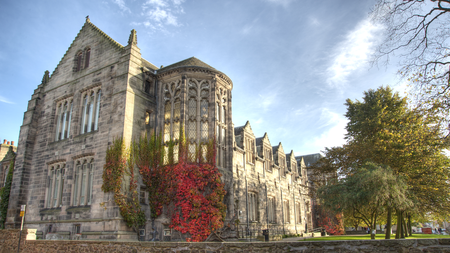
Chair in Biological Sciences, Head of School of Biological Sciences
- About
-
- Email Address
- g.i.paton@abdn.ac.uk
- Telephone Number
- +44 (0)1224 273834
- Office Address
- Room 2.22 Cruickshank Building
- Room 2.12 Zoology Building
- School/Department
- School of Biological Sciences
External Memberships
- Director of QUADRAT-DTP
- Overview for new QUADRAT-DTP Supervisors
- Director - Remedios Limited
- Editorial Board for Soil Biology and Biochemistry
- Editorial Board for Water Air Soil Pollution
- Research
-
Research Overview
I study the relationship between pollutant speciation and toxicity. This considers the fate and transformation of environmental pollutants. This is done through the use of analytical chemical tools to study organism responses to pollutants. I am also enthused by the application and comparison of ecotoxicity assays to various environmental sample. I also use general research skills in soil microbiology and biochemistry. Specific areas of interest are:
- Fate of inorganic/ organic pollutants in the environment
- Development of bioassays to assess environmental toxicity
- Chemical and biological techniques for environmental restoration
- Soil genesis and classification and linkage to soil biology
Research Areas

Research Specialisms
- Environmental Biotechnology
- Environmental Sciences
- Environmental Chemistry
- Soil Science
- Applied Environmental Sciences
Our research specialisms are based on the Higher Education Classification of Subjects (HECoS) which is HESA open data, published under the Creative Commons Attribution 4.0 International licence.
Current Research
Current Research Group
The current research group has several strands. Mostly the focus is on process level soil microbiology as a response to perturbations- mainly pollution. Biosensors are widely used to quantify and better understand these mpacts and to relate to the aspects of bioavailability. To an extent these enable sustainable solutions to be developed and bespoke risk assessment to be measured.
If you are interested in joining the group then have a think about the work that the current group and recently completed members have contributed.
Dr. Lenka Mbadugha complements the research team with her expertise in pollution monitoring, biosensor development and soil carbon dynamics.
Rosie Boyko has completed her PhD studying the link between soil pH management and sward quality with reference to Scotland and food security. Thnayan Alonaizi is studying soil-based enzymes to devise recolonisation techniques in impacted soils. This bioaugmentation work is a new twist of remediation work with hydrocarbons that we have done in the past. He is also transplanting functional biomes back into soils. Onome Omovie-Stephen is applying techniques for carbon fractionation to contrastingly managed soils to try and develop techniques to better sequester soil carbon. The great challenge is to understand carbon partitioning and links to function and availability.
Sapar Dossanov integrated approaches of risk and hazard assessment in current and historic metal mines. This work has been further enhanced by Sandra Arroyo Sanchez who has upskilled the use of SEM and applied the risk assessment/ human exposure/ model approaches to Mexico. Both successfully defended their PhD is Q1 of 2024- congratulations.
Alexander Kani is studying bioleaching of metal wastes as a process for elemental recovery in a sustainable manner. The focus is on critical elements and we have widened the scope from mine wastes to other matrices and are developing resin based systems for capture.
Christoph Gade studies elemental cycling of mercury with a focus on marine sources and fate but extends this to wider geochemical concepts. The driver here is to truth test models that have been established making use of specific analytical approaches. He has also established some effective and innovative ecotoxicological testing.
Rita Moussa is a Hydro-Nation student and works on anaerobic systems for the sustainable generation of methane and hopefully hydrogen.
Aftab Majeed studied urban ecology with respect to planning challenges from a quantitative basis. He also recently defended his PhD.
Former Members of the Research Group
Dr. Barry Nourice studied the fragile status of soils in the Seychelles.
Dr. Victor Igwe focussed on microbial processes in the production of bioethanols. This made use both of empirical and modelling approaches.
Dr. Amira Alzadjali developed new elemental specific biosensors to update the current suite used by the group in environmental diagnostics.
Dr. Abubakar Yuguda devised methods to apply mycorrhizal enhanced maize plants in the remediation of soils impacted with effluents from the tannery industry.
Dr. Chisom Agunwoke developed biosensors for soil and sediment remediation.
Dr. Mouza Al Mansouri studied sustainable water storage in Abu Dhabi where she works as the Director in Spatial Data Analysis at the Environment Agency.
Dr. Saad Dehlawi completed his research using chemical additives to enhance mobility and complexation of pollutants as a strategic technique for land and water remediation.
Dr. Chidinma Anunike used CaSx with a specific focus on the consideration of hexavalent chromium transformation.
Dr. Hedda Weitz, who developed a range of bacterial biosensors and the only effective fungal biolouminescence-based assay, oversees the smooth running of the microbial laboratory. Jamie Buckingham oversees the challenges of soils, environmental samples and chemical analysis within the group.
Here is a tour of the facilities
Collaborations
Prof. Kirk Semple, Lancaster University
- Teaching
-
Teaching Responsibilities
Course Co-Coordinator
- Land Use and the Changing Environment
- Publications
-
Page 3 of 3 Results 101 to 124 of 124
Lighting the way for bioremediation
Chemistry & Industry, vol. 3, pp. 77-79Contributions to Journals: ArticlesRecommendations for testing toxicity to microbes in soil
Chapters in Books, Reports and Conference Proceedings: Conference ProceedingsSoil solution extraction techniques for microbial ecotoxicity testing: a comparative evaluation
Journal of Environmental Monitoring, vol. 3, pp. 91-96Contributions to Journals: Articles- [ONLINE] DOI: https://doi.org/10.1039/b007851o
Use of bacterial biosensors to interpret the toxicity and mixture toxicity of herbicides in freshwater
Water research, vol. 35, no. 14, pp. 3490-3495Contributions to Journals: Articles- [ONLINE] DOI: https://doi.org/10.1016/S0043-1354(01)00065-3
What do microbial biosensors tell us about the behavior of MTBE?
Chapters in Books, Reports and Conference Proceedings: Conference ProceedingsBiosensing the acute toxicity of metal interactions: Are they additive, synergistic, or antagonistic?
Environmental Toxicology and Chemistry, vol. 19, pp. 775-780Contributions to Journals: ArticlesComparison of methods to investigate microbial populations in soils under different agricultural management
FEMS Microbiology Ecology, vol. 33, pp. 129-137Contributions to Journals: ArticlesCopper speciation and impacts on bacterial biosensors in the pore water of copper-contaminated soils
Environmental Science & Technology, vol. 34, pp. 5115-5121Contributions to Journals: Articles- [ONLINE] DOI: https://doi.org/10.1021/es/0000910
Development of robust, environmental, immunoassay formats for the quantification of pesticides in soil
Environmental Science & Technology, vol. 34, pp. 1603-1608Contributions to Journals: ArticlesInvestigating the specificity of regulators of degradation of hydrocarbons and hydrocarbon-based compounds using structure-activity relationships
Biodegradation, vol. 11, pp. 37-47Contributions to Journals: ArticlesResponse of a Rhizobium-based luminescence biosensor to Zn and Cu in soil solutions from sewage sludge treated soils
Soil Biology and Biochemistry, vol. 32, pp. 383-388Contributions to Journals: ArticlesAssessing metal bioavailability in soils using luminescence-based microbial biosensors
Chapters in Books, Reports and Conference Proceedings: Conference ProceedingsAssessment of acute PAH toxicity using prokaryote biosensors.
Chapters in Books, Reports and Conference Proceedings: Conference ProceedingsAssessment of the toxicity of metals in soils amended with sewage sludge using a chemical speciation technique and a lux-based biosensor
Environmental Toxicology and Chemistry, vol. 18, pp. 659-663Contributions to Journals: ArticlesDetermination of acute Zn toxicity in pore water from soils previously treated with sewage sludge using bioluminescence assays
Environmental Science & Technology, vol. 33, pp. 1880-1885Contributions to Journals: ArticlesLux-biosensor assessment of pH effects on microbial sorption and toxicity of chlorophenols
FEMS Microbiology Letters, vol. 174, pp. 273-278Contributions to Journals: ArticlesMetal remediation of soil via phosphate formation: Bone meal treatments
Chapters in Books, Reports and Conference Proceedings: Conference ProceedingsFeasibility of using prokaryote biosensors to assess acute toxicity of polycyclic aromatic hydrocarbons
FEMS Microbiology Letters, vol. 169, no. 2, pp. 227-233Contributions to Journals: Articles- [ONLINE] DOI: https://doi.org/10.1016/S0378-1097(98)00490-X
Application of bioluminescence-based microbial biosensors to the ecotoxicity assessment of organotins
Letters in Applied Microbiology, vol. 25, no. 5, pp. 353-358Contributions to Journals: Articles- [ONLINE] DOI: https://doi.org/10.1046/j.1472-765X.1997.00231.x
- [ONLINE] View publication in Scopus
Development of an acute and chronic ecotoxicity assay using lux-marked Rhizobium legunninosarum biovar trifolii
Letters in Applied Microbiology, vol. 24, no. 4, pp. 296-300Contributions to Journals: Articles- [ONLINE] DOI: https://doi.org/10.1046/j.1472-765X.1997.00071.x
- [ONLINE] View publication in Scopus
Comparative assessment of the toxicity of a papermill effluent by respirometry and a luminescence-based bacterial assay
Chemosphere, vol. 32, no. 8, pp. 1553-1561Contributions to Journals: Articles- [ONLINE] DOI: https://doi.org/10.1016/0045-6535(96)00062-8
- [ONLINE] View publication in Scopus
Soil ecotoxicity assessment using lux‐modified constructs of Pseudomonas fluorescens
Soil Use and Management, vol. 11, no. 3, pp. 153-154Contributions to Journals: Articles- [ONLINE] DOI: https://doi.org/10.1111/j.1475-2743.1995.tb00521.x
- [ONLINE] View publication in Scopus
Assessment of bioavailability of heavy metals using lux modified constructs of Pseudomonas fluorescens
Letters in Applied Microbiology, vol. 20, no. 1, pp. 52-56Contributions to Journals: Articles- [ONLINE] DOI: https://doi.org/10.1111/j.1472-765X.1995.tb00406.x
- [ONLINE] View publication in Scopus
Use of luminescence-marked bacteria to assess copper bioavailability in malt whisky distillery effluent
Chemosphere, vol. 31, no. 5, pp. 3217-3224Contributions to Journals: Articles- [ONLINE] DOI: https://doi.org/10.1016/0045-6535(95)00183-9
- [ONLINE] View publication in Scopus
